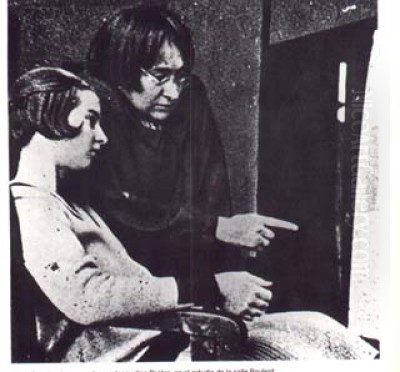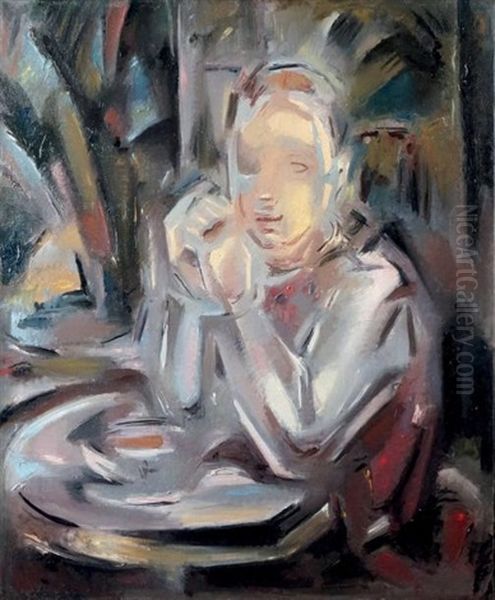
María Gutiérrez-Cueto y Blanchard, known to the art world as Maria Blanchard, stands as a significant, if sometimes overlooked, figure in the vibrant tapestry of early 20th-century European art. A Spanish painter, she navigated the currents of modernism, most notably Cubism, with a distinctive sensibility, infusing geometric rigor with profound emotional depth. Her life, marked by physical adversity and unwavering dedication to her craft, and her art, characterized by a unique synthesis of avant-garde principles and personal expression, offer a compelling narrative of resilience and artistic integrity.
Early Life and Formative Influences in Spain
Born in Santander, Cantabria, in 1881, Maria Blanchard's early life was shaped by a congenital condition, kyphoscoliosis (a severe curvature of the spine), resulting from an accident her mother experienced during pregnancy. This physical difference subjected her to social ostracism and bullying during her formative years, experiences that undoubtedly contributed to a deep-seated melancholy and introspection that would later permeate her art. Her father, Enrique Gutiérrez Cueto, was a journalist, and her mother, Concepción Blanchard, provided a supportive, if conventional, middle-class upbringing.
Despite the challenges, Blanchard's artistic inclinations were evident early on. In 1903, she moved to Madrid to pursue formal art training at the Royal Academy of Fine Arts of San Fernando. There, she studied under prominent Spanish academic painters such as Emilio Sala and Manuel Benedito. These instructors instilled in her a solid foundation in traditional drawing techniques and the nuanced use of color, skills that would underpin her later, more radical explorations. Her early works from this period, though academic in style, already hinted at a keen observational skill and a sensitivity to her subjects.
A pivotal moment in her early career came in 1909 when her painting "Primeros pasos" (First Steps) was awarded a third-class medal at the National Exhibition of Fine Arts. This recognition brought with it a grant from the Santander Provincial Council, enabling her to pursue further studies in Paris, the undisputed epicenter of the art world at the time.
Paris: Immersion in the Avant-Garde

Arriving in Paris around 1909, Blanchard initially enrolled at the Académie Vitti, where she studied under artists like Hermenegildo Anglada Camarasa and Kees van Dongen. This period marked her initial immersion into the ferment of modern art. Paris was a crucible of artistic innovation, with Fauvism having recently shocked the establishment and Cubism, spearheaded by Pablo Picasso and Georges Braque, beginning to deconstruct traditional notions of form and space.
It was in this dynamic environment that Blanchard encountered the artists who would profoundly shape her artistic trajectory. She became closely associated with the burgeoning Cubist movement, forging significant friendships with key figures. Among these, the Spanish painter Juan Gris became a particularly close friend and a crucial artistic influence. Gris, along with Picasso and Braque, was a leading proponent of Cubism, and his analytical yet lyrical approach to the style resonated deeply with Blanchard.
She also moved in circles that included other prominent artists like the Mexican muralist Diego Rivera, who was then experimenting with Cubism, the sculptor Jacques Lipchitz, and the French painter André Lhote. Lhote, like Blanchard, sought to reconcile Cubist principles with a degree of traditional composition and legibility. Blanchard became an active participant in the discussions and exhibitions of the Parisian avant-garde, absorbing the intellectual and aesthetic currents that were reshaping visual art.
The Cubist Engagement
By 1913, Maria Blanchard had fully embraced Cubism, developing her own distinct interpretation of the style. She became associated with the Section d'Or (or Puteaux Group), an offshoot of Cubism that included artists such as Albert Gleizes, Jean Metzinger, Fernand Léger, and Francis Picabia, as well as the Duchamp brothers – Marcel Duchamp, Jacques Villon, and Raymond Duchamp-Villon. This group was keen on exploring the mathematical and theoretical underpinnings of Cubism, often exhibiting a more colorful and dynamic approach than the more austere, monochromatic works of early Picasso and Braque.
Blanchard's Cubist works from this period, roughly 1913 to 1919, are characterized by a sophisticated understanding of geometric fragmentation, multiple perspectives, and a vibrant, often non-naturalistic, color palette. Unlike the sometimes detached intellectualism of some of her male counterparts, Blanchard's Cubism often retained a palpable emotional charge. Her compositions, while rigorously structured, frequently featured human figures and still lifes imbued with a subtle poignancy.
Representative works from this phase include "Composición cubista" (Cubist Composition) and "Mujer con abanico" (Woman with a Fan). These paintings demonstrate her ability to dissect and reassemble forms, creating complex, faceted surfaces that engage the viewer's perception. "Still Life with a Box of Matches" is another notable example, lauded for its intricate composition and bold color harmonies, holding its own among the finest examples of Synthetic Cubism. She exhibited her work at important avant-garde showcases, including the Salon des Indépendants in Paris in 1913.
Interlude in Spain and Return to Paris
The outbreak of World War I in 1914 compelled Blanchard to return to Spain. She settled in Madrid, where she shared a studio with Diego Rivera for a time. During this period, she participated in the "Exposición de Pintores Íntegros" (Exhibition of Integral Painters) organized by Ramón Gómez de la Serna in 1915, an attempt to introduce modern art trends to a largely conservative Spanish art scene. She also briefly took up a teaching position in Salamanca, an experience she reportedly found unfulfilling.
The war years were a period of relative artistic isolation compared to the dynamism of pre-war Paris. However, Blanchard continued to develop her Cubist language. Once the war concluded, she eagerly returned to Paris in 1918, which would remain her home for the rest of her life. This return marked a renewed commitment to her artistic career in the heart of the European art world.
Post-Cubism: A Return to Figuration with Emotional Depth
Around 1920, Maria Blanchard's style began to evolve. While the structural lessons of Cubism remained deeply ingrained in her work, she gradually moved away from its more abstract and fragmented aspects towards a more figurative and emotionally expressive style. This shift did not represent a rejection of modernism but rather a personal synthesis, a desire to imbue her figures with a greater sense of humanity and psychological presence.
Her subjects during this period often centered on themes of domesticity, childhood, and maternity, as well as poignant portrayals of individuals marked by vulnerability or introspection. Works like "The Communicant," "The Child with a Hoop," and "The Sick Child" are exemplary of this phase. Her figures, though rendered with a degree of realism, often possess a sculptural solidity and a quiet dignity, their forms sometimes subtly stylized with echoes of her Cubist past. Her color palette remained rich and expressive, contributing significantly to the emotional tenor of her paintings.
Paintings such as "The Fortune-Teller" and "Jeune Fille Assise à une Table" (Young Girl Seated at a Table) showcase this mature style, where the human element is paramount. These works are characterized by their tender observation, their melancholic undertones, and a profound empathy for her subjects. Some critics have seen in this shift a reflection of her own experiences of suffering and her deep Catholic faith, which became increasingly important to her in her later years.
Friendships, Challenges, and Artistic Recognition
Throughout her career in Paris, Blanchard maintained important artistic friendships. Her bond with Juan Gris was particularly profound. They shared not only a common Spanish heritage and a commitment to Cubism but also a deep personal understanding. Gris's premature death in 1927 was a devastating blow to Blanchard, leading to a period of increased isolation and depression. She reportedly withdrew from many of her social and artistic circles following this loss.
Despite the personal and emotional challenges, Blanchard achieved a degree of recognition during her lifetime. She had her first solo exhibition at Léonce Rosenberg's prestigious Galerie de L'Effort Moderne in Paris, a key venue for Cubist artists. Her work was also exhibited in Brussels, including at the "Cubismo y Neocubismo" exhibition, and she participated in shows like the "21 Exposición de Artistas Franceses Avant-garde" in Paris. She found patrons, such as the Belgian collector Frank Flausch, who provided crucial support, especially during periods of financial hardship.
However, as a female artist in a male-dominated art world, and one with a visible physical disability, Blanchard faced considerable obstacles. Her work was sometimes unfairly compared to that of her male contemporaries, or dismissed as overly sentimental when she moved towards more figurative themes. The economic instability of the post-war years and the Great Depression also impacted art sales, creating financial insecurity.
Later Years, Spiritual Reflection, and Legacy
In her later years, Blanchard's health deteriorated. She suffered from tuberculosis, which further compounded her physical frailties. Her art during this final period took on an increasingly spiritual and introspective quality. Religious themes became more prominent, and her figures often conveyed a sense of quiet suffering or serene contemplation. Her palette, while still rich, could also tend towards more somber tones, reflecting her declining health and perhaps a deepening spiritual awareness.
Maria Blanchard died in Paris in 1932 at the age of 51, leaving behind a significant body of work. While she may not have achieved the same level of widespread fame as some of her male Cubist colleagues like Picasso, Braque, or even Gris during her lifetime, her contribution to modern art is undeniable. She was one of the few women to play an active and innovative role within the Cubist movement, bringing a unique emotional intensity and a distinctive use of color to its formal explorations.
Posthumously, her work has gained increasing recognition. Exhibitions, including a tribute at the Ateneo in Madrid, have helped to re-evaluate her place in art history. Her paintings are now held in major museum collections, including the Museo Nacional Centro de Arte Reina Sofía in Madrid, the Centre Pompidou in Paris, and the Courtauld Institute of Art in London.
Maria Blanchard's art stands as a testament to her resilience and her singular vision. She successfully navigated the complex artistic landscape of early 20th-century Paris, absorbing the lessons of the avant-garde while forging a deeply personal style. Her journey from the academic studios of Madrid to the heart of Cubism, and her subsequent evolution towards a poignant figuration, reveals an artist of profound sensitivity and unwavering commitment. Her legacy is not only that of a pioneering female Cubist but also of an artist who masterfully conveyed the depths of human emotion through the innovative language of modernism, influencing by her example other artists who sought to blend formal innovation with personal expression, such as her contemporary, the painter Sonia Delaunay, who also carved a unique path in abstract art. Blanchard's ability to infuse the intellectual rigor of Cubism with a deeply felt humanity ensures her enduring importance in the narrative of modern art.